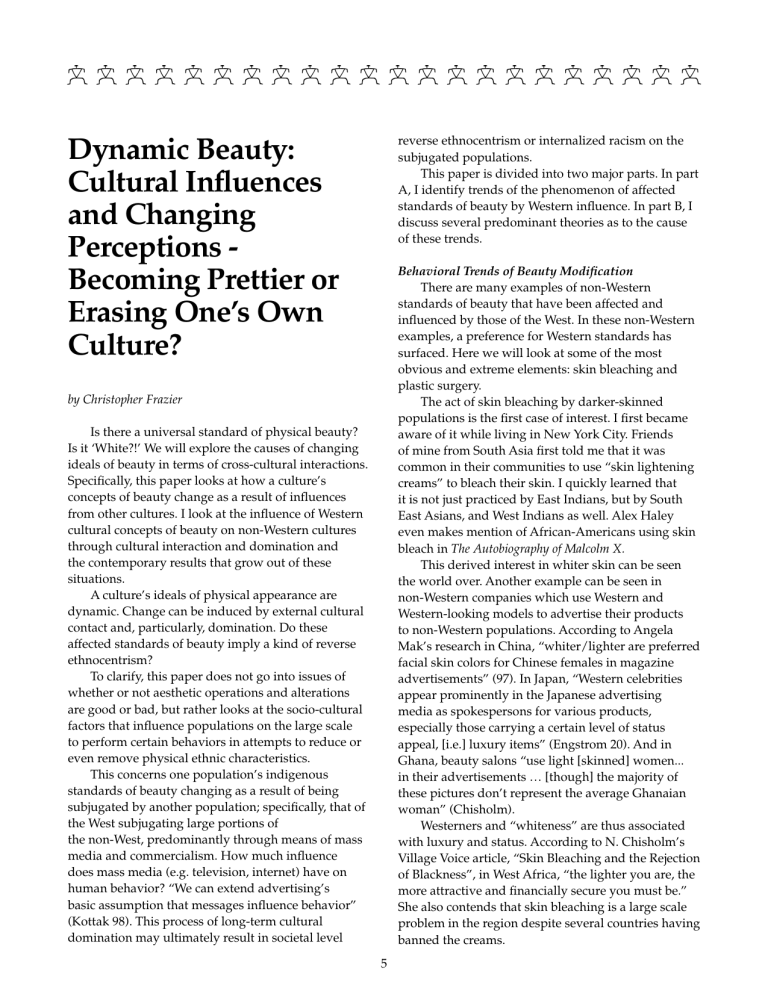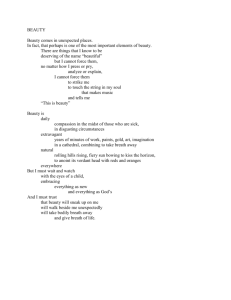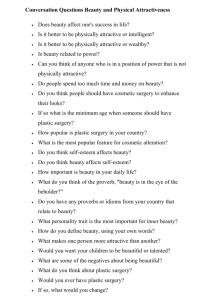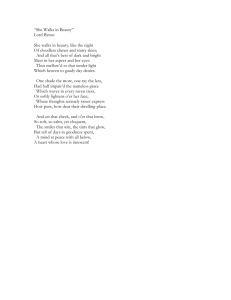Dynamic Beauty: Cultural Influences and Changing Perceptions

;;;;;;;;;;;;;;;;;;;;;;
Dynamic Beauty:
Cultural Inßuences and Changing
Perceptions -
Becoming Prettier or
Erasing OneÕs Own
Culture?
by Christopher Frazier
Is there a universal standard of physical beauty?
Is it ÔWhite?!Õ We will explore the causes of changing ideals of beauty in terms of cross-cultural interactions.
SpeciÞcally, this paper looks at how a cultureÕs concepts of beauty change as a result of inßuences from other cultures. I look at the inßuence of Western cultural concepts of beauty on non-Western cultures through cultural interaction and domination and the contemporary results that grow out of these situations.
A cultureÕs ideals of physical appearance are dynamic. Change can be induced by external cultural contact and, particularly, domination. Do these affected standards of beauty imply a kind of reverse ethnocentrism?
To clarify, this paper does not go into issues of whether or not aesthetic operations and alterations are good or bad, but rather looks at the socio-cultural factors that inßuence populations on the large scale to perform certain behaviors in attempts to reduce or even remove physical ethnic characteristics.
This concerns one populationÕs indigenous standards of beauty changing as a result of being subjugated by another population; speciÞcally, that of the West subjugating large portions of the non-West, predominantly through means of mass media and commercialism. How much inßuence does mass media (e.g. television, internet) have on human behavior? ÒWe can extend advertisingÕs basic assumption that messages inßuence behaviorÓ
(Kottak 98). This process of long-term cultural domination may ultimately result in societal level
5 reverse ethnocentrism or internalized racism on the subjugated populations.
This paper is divided into two major parts. In part
A, I identify trends of the phenomenon of affected standards of beauty by Western inßuence. In part B, I discuss several predominant theories as to the cause of these trends.
Behavioral Trends of Beauty ModiÞcation
There are many examples of non-Western standards of beauty that have been affected and inßuenced by those of the West. In these non-Western examples, a preference for Western standards has surfaced. Here we will look at some of the most obvious and extreme elements: skin bleaching and plastic surgery.
The act of skin bleaching by darker-skinned populations is the Þrst case of interest. I Þrst became aware of it while living in New York City. Friends of mine from South Asia Þrst told me that it was common in their communities to use Òskin lightening creamsÓ to bleach their skin. I quickly learned that it is not just practiced by East Indians, but by South
East Asians, and West Indians as well. Alex Haley even makes mention of African-Americans using skin bleach in The Autobiography of Malcolm X.
This derived interest in whiter skin can be seen the world over. Another example can be seen in non-Western companies which use Western and
Western-looking models to advertise their products to non-Western populations. According to Angela
MakÕs research in China, Òwhiter/lighter are preferred facial skin colors for Chinese females in magazine advertisementsÓ (97). In Japan, ÒWestern celebrities appear prominently in the Japanese advertising media as spokespersons for various products, especially those carrying a certain level of status appeal, [i.e.] luxury itemsÓ (Engstrom 20). And in
Ghana, beauty salons Òuse light [skinned] women... in their advertisements É [though] the majority of these pictures donÕt represent the average Ghanaian womanÓ (Chisholm).
Westerners and ÒwhitenessÓ are thus associated with luxury and status. According to N. ChisholmÕs
Village Voice article, ÒSkin Bleaching and the Rejection of BlacknessÓ, in West Africa, Òthe lighter you are, the more attractive and Þnancially secure you must be.Ó
She also contends that skin bleaching is a large scale problem in the region despite several countries having banned the creams.
The other most extreme illustration of this trend of non -Western populations borrowing from Western standards of beauty can be seen in the increasing frequency of surgical operations which altogether alter the ethnic appearance of recipients. This is particularly common in East Asia and East Asian populations in places like North America.
The most commonly practiced operation is called blepharoplasty, which is also referred to as Òeyelid surgery.Ó The operation Òcreates an indention of the eyelid right on the top of the eyeball that makes it stand outÓ giving the eyelid a double-fold (Valhouli).
Ann Shin, a Þlmmaker who made a movie on this topic, said of the situation in Canada: Òwomen will encourage their [daughters] to think about getting eyelid surgery in the way that parents might get braces for a kid or have an overweight child lose some weightÓ (Kar) .
In 1998, ÒAsian-Americans represented 7.5 percent of all patients undergoing facial cosmetic surgery,Ó according to the American Academy of
Facial, Plastic and Reconstructive Surgery
(Valhouli). The statistics are staggering; Ò[In] Korea, surgeons estimate that at least one in 10 adults have received some form of surgical upgradeÓ (Cullen et al) .
Following blepharoplasty in popularity is an operation that makes the nose appear longer and pointer and another operation in which Òbotox is injected into wide cheeks so the muscle will atrophy and the cheeks will shrinkÓ (Cullen et al).
So whoÕs to blame? How about Michael Jackson?
Is he not the epitome of both of the above described acts of physical alteration? Catherine Tetteh, a beautician in Geneva points out, Òby using cosmetic surgery to make his face look more European, Michael
Jackson, was sending out the wrong signal.Ó Of course we cannot place blame on one popular icon but it can offer illumination.
Explanations and Variables
All of the above trends seem to illustrate the growing inßuence of Western cultural domination.
From actual imperialism to modern cultural colonialism via mass media, Òfew would argue that under the relentless bombardment of Hollywood, satellite TV, and Madison Avenue, AsiaÕs aesthetic ideal has changed drasticallyÓ(Cullen et al). But is all this change solely the result of Western inßuence?
And what role, if any, does reverse ethnocentrism play in the adoption of Western standards and the downplaying of indigenous ones?
There are several variables that point to causes other than the cultural domination of the West that some argue have played a part in the changing ideas of beauty. For example, in the case of China, researcher Angela Mak explains:
We can go beyond the media inßuence of the last 40 years and look at the possibly deeper and earlier explanations for light skin preference: that elite people donÕt need to labor outside, thus in Southern China, developed an association of ÒwhitenessÓ with status.
She goes on to mention that the above occurrence coupled with the later colonization of Hong Kong by the British CaucasiansÓreinforced the ideaÓ (88-89).
In Japan, before large scale Western inßuence, opinions of Caucasians were quite negative. One scholar in 1807 even described Westerners as being beasts that resembled human beings (Engstrom 18).
However, not long after the West was recognized as being Òtechnologically and economically superior to Japan... [which began the belief by Japanese] that
Japan was inferior, not only as an economic power, but also as a raceÓ (Engstrom 19). This inferiority complex developed into what Japanese call retto-kan, or Òinferior class feeling,Ó to the West (17,19).
Many of the arguments for surgery or bleaching include beliefs that doing so will increase status or improve an individualÕs chances of success in competitive societies (Kar; Chisholm).
On surgery, some people claim that the practice has nothing to do with trying to look more Western.
They just want to look more attractive or as one surgeon put it, Òthe Asian eye is beautiful and
[recipients]Õre only trying to enhance it [by surgical operation]Ó (quoted by Valhouli). But, as Valhouli points out, this argument breaks down Òinto a game of semantics... [in which] people sayÕ I want to look prettierÕ ...but how does it come to mean a Western eye?Ó And this observation of semantics brings up another example, one that I noticed. The word fair has come to mean light complexioned; however, fair used to mean beautiful, as in ShakespeareÕs use when he describes a fair maiden.
Skin bleaching is a little clearer cut in its origins, especially in West Africa, since it started in the 1500s as the Europeans came and colonized (Chisholm).
6
Conclusion
This paper only scratches the surface of an interesting area that should not be neglected.
This is an interdisciplinary Þeld in which both
Anthropological and Mass Communication type theories can be useful in better understanding these cultural dynamics.
In this paper, we looked at examples of non-
Western peoples adopting Western standards of beauty, and adjusting their appearance accordingly through such means as skin bleaching and plastic surgery. Also, we looked at potential causes and effects of this phenomenon.
In conclusion, we can assume that Western inßuence has played a role in these new behaviors.
However, we cannot clearly distinguish these behaviors as indicators of a growing internalized racism on the societal level.
Wanting to look good is natural. However, when people adopt foreign standards of beauty and then attempt to recreate them in their own communities, it may have negative consequences. I have to agree with USC anthropologist professor Soo-Young Chin in her opinion: ÒI think itÕs silly to think there is only one standard of beauty. And letÕs face it, most people arenÕt beautiful, theyÕre just mediocreÓ (Valhouli).
WORKS CITED AND RELATED READING
Bodley, John. Victims of Progress. Mountain View,
California: MayÞeld Publishing Company,
1999.
Chisholm, N. ÒSkin Bleaching and the Rejection of
Blackness.Ó Village Voice 22-28 Jan. 2001. 16
Oct. 2004.
<http://villagevoice.com/issues/0204/ chisholm.php>
Cullen, Lisa, et al. ÒChanging FacesÓ Times Asia. 5
Aug. 2002. Oct. 2004
<http://www.time.com/time/asia/covers/ ll0l020805/story.htm>
Engstrom, Erika. ÒRetto-kan: JapanÕs Inferiority
Complex with the West in Contemporary
Media and Culture.Ó Human Communication: a Journal of the PaciÞc and Asian
Communication Association 1.1(1997): 17-23.
Hovland, Carl, Irving Janis and Harold Kelly.
Communication and Persuasion:
Psychological Studies of Opinion Change.
New Haven: Yale University Press, 1953.
Kar, Rima. ÒThe Eyes Have It.Ó MacleanÕs 28 May
2001: 40.
Klapper, Joseph. The Effects of Mass Communication.
New York: Free Press, 1960.
Lester, Paul, ed. Images That Injure: Pictorial
Stereotypes in the Media. Westport,
Connecticut: Praeger, 1996.
Lutz, Catherine and Jane Collins. Reading National
Geographic. Chicago: University of Chicago
Press, 1993.
Mak, Angela. ÒFacial Skin Color Preferences for
Chinese Women in Hong Kong Magazine
Advertisements.Ó Human Communication: a Journal of the PaciÞc and Asian
Communication Association 2.1 (1998-1999):
87-97.
Poblete, Patio ÒThe price to pay for an ÔAmericanÕ nose and eyes is more than the $2,500Ó San
Francisco Chronicle 24 Feb.2002. Oct. 2004
<http://modelminority.com/modules.php?n
ame=News&Þle=articl e&sid=430>
7
Valhouli, Christina. ÒÕFixingÕ the Asian Eye- Racist or no Big Deal?Ó Talk Surgery, Inc. 2001-2004.
Oct. 2004 <http://www.talksurgery.com/ consumer/new/newOOOOO085_4.htm>









